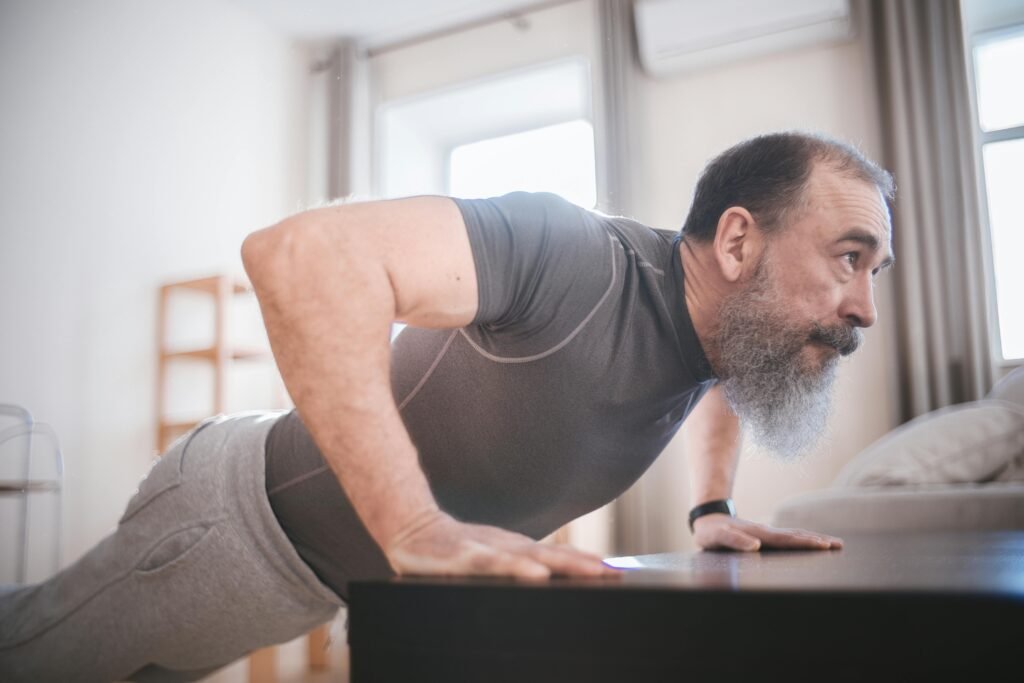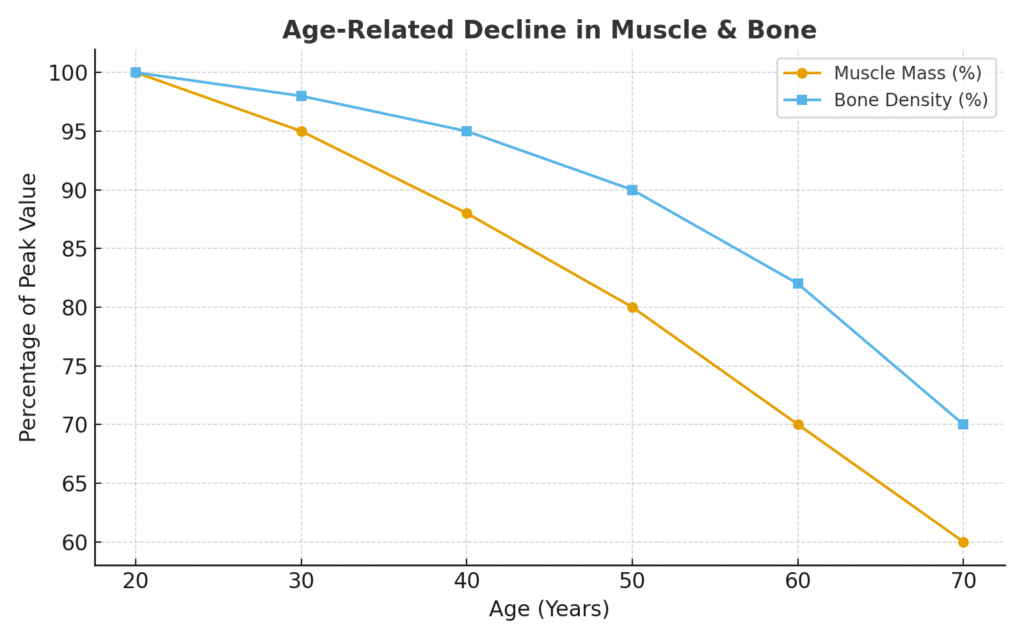5 Minutes a Day to Transform Your Body: The Science, Habits, and Real-Life Benefits of Strength Training
The On Purpose Podcast with Senada Greca | August 26, 2025
Why 5 Minutes Can Change Everything
Most people dismiss a 5-minute workout as useless. After all, how much can you really achieve in such a short time? The truth is, those 5 minutes aren’t about instant physical change — they’re about creating consistency and building a foundation for a lifetime of fitness. Research shows that habits begin to form in about 21 days and become more deeply ingrained after around 66 days. By committing to just five minutes a day, you’re sending a signal to your body and mind: I’m prioritizing my health.

Think of it like saving money: dropping a single coin in a jar each day won’t make you rich overnight, but over weeks, months, and years, that jar becomes heavy. The same principle applies to your health. Five minutes of movement primes your body and builds confidence that you can show up consistently. Over time, this momentum carries you to longer sessions, more intense workouts, and visible progress. The mental win is even bigger: you’re proving to yourself daily that you can keep promises you make to yourself. That builds trust, self-discipline, and self-respect, which spill into other areas of life — from career success to personal relationships.
Takeaway: 5 minutes may not transform your physique overnight, but it can transform your mindset — and that’s what leads to lasting results.

This chart shows how habits strengthen over time. The first 21 days build the foundation, but true consistency comes after 66 days. That’s why short, repeatable actions matter far more than ambitious, unsustainable routines.
From Depression to Strength: A Real-Life Journey
Many people start working out for the wrong reasons — often chasing unrealistic body standards. Sonada Grekër, a global thought leader in fitness, shared how she struggled with depression, anxiety, and eating disorders before discovering the transformative power of strength training. What shifted her path wasn’t dieting to be skinny, but learning to build strength for mental health. Exercise reduced her symptoms of depression more effectively than medication alone.
This isn’t just her story — it’s supported by science. Studies reveal that just 150 minutes of activity per week (a little over 20 minutes a day) can reduce symptoms of depression by 42–60% — a far greater effect than many medications, which average 20–30% improvement. For someone battling anxiety or low self-esteem, those numbers are life-changing. Fitness becomes more than just exercise: it’s medicine, therapy, and empowerment rolled into one.
Takeaway: Fitness is more than aesthetics — it’s one of the most effective natural antidepressants available.
Start Small: How to Build Your Routine
If you’ve ever felt overwhelmed by the idea of working out, the key is to start small. Don’t plan a 60-minute gym session if you can barely commit to 5 minutes — that’s like trying to climb Mount Everest before you’ve walked a mile. Success comes from baby steps.
Here’s how to ease in:
- Begin with 5 minutes of simple moves like squats, planks, or walking in place.
- Once consistent, scale up to 10–20 minutes.
- Create a supportive environment — lay out workout clothes the night before, or dedicate a corner of your home as a mini-gym.
- Pick the time of day you feel most energetic. While studies suggest 11 a.m.–5 p.m. might be optimal, the best time is the one you’ll actually stick to.
Another trick is habit stacking — linking a new workout routine with an existing habit. For example, do 10 push-ups after brushing your teeth, or walk around the block after your morning coffee. By pairing new habits with old ones, your brain treats the workout as a natural extension of something you already do, making it easier to stick with long term.
Pro Tip: If you struggle with motivation, pair your workout with something enjoyable — like watching your favorite show while doing bodyweight exercises.
The Power of Strength Training
While cardio and Pilates all have benefits, strength training is the golden standard for longevity. Here’s why:
- Muscle Mass Decline: After age 30, we naturally lose 3–8% of muscle per decade.
- Bone Density Decline: Peak bone density occurs around age 25–30, then begins to decrease. After 40, we lose bone faster than we can build it.
- Longevity Impact: Falls and fractures in older adults are often fatal. In the U.S., over 32,000 deaths annually result from fall-related injuries among people over 65.
By incorporating strength training now, you prepare your body to remain independent and resilient later in life. Unlike cardio, which primarily strengthens your heart and burns calories, resistance work physically reinforces your skeleton, builds joint stability, and enhances balance. This means fewer injuries, quicker recovery, and more confidence as you age.
Key Insight: If you want one exercise habit that gives you the best return for your future self, choose strength training.

This chart shows how both muscle mass and bone density decline with age. Strength training slows these losses, protecting mobility and independence. Think of it as an investment account for your body: the earlier you start contributing, the bigger your balance of strength and resilience in later years.
Busting the Biggest Myths
“Strength training makes women bulky.”
False. Hormonal differences prevent most women from developing excessive bulk naturally. Instead, women gain lean muscle, tone, and confidence. In fact, many women discover they feel more feminine, not less, when they lift weights because strength enhances posture, energy, and body confidence.
“Cardio is the best way to lose fat.”
Not exactly. Fat loss depends on a caloric deficit (calories in vs. calories out). Strength training builds muscle, which burns more calories even at rest, making it a powerful fat-loss tool. Cardio can support heart health, but it doesn’t build the long-term metabolic engine that lifting does.
“I don’t have time.”
Reality check: if you have time to scroll social media, you have time to move your body for 5–20 minutes. Many people even exercise while watching TV. It’s not about hours in the gym — it’s about making the minutes you do have work for you.
Takeaway: The barrier isn’t time — it’s prioritization.
Nutrition: Fueling Your Strength
Food is fuel, and the right nutrition plan can supercharge your results. Here are key principles:
- Protein is Priority: Aim for 0.8–1 gram of protein per pound of body weight daily. For a 120-pound person, that’s around 120 grams per day. This helps repair muscles and supports growth.
- Balance Carbs & Fats: Use complex carbs (whole grains, fruits, vegetables) over refined sugars. Healthy fats like avocado, olive oil, and nuts support hormone health.
- Pre-Workout Fuel: Light protein + carbs about an hour before training. This could be something as simple as Greek yogurt with berries.
- Post-Workout Fuel: At least 20 grams of protein to support recovery. Examples include a protein shake, eggs, or tofu.
Most people underestimate how much protein they need. Without it, you may feel fatigued, struggle to recover, and fail to see progress despite working hard. A good rule of thumb is to include protein in every meal and snack — from smoothies to hummus with veggies.
Pro Tip: Many people under-consume protein. Track your meals for a week — you might be shocked at how far below your target you are.
Overcoming Mental Barriers
Fitness is as much mental as it is physical. Here are three major roadblocks:
- Motivation vs. Habit: Don’t wait to “feel motivated.” Treat workouts like brushing your teeth — non-negotiable. Even elite athletes don’t wake up motivated every day; they succeed because they act despite their feelings.
- All-or-Nothing Thinking: You don’t need a perfect workout plan. Even a short session matters. Missing one day isn’t failure — it’s life. What matters is what you do the next day.
- Self-Talk Matters: Replace “I hate my body” with “I’m grateful for my body and working to make it stronger.” Your words shape your mindset, and mindset fuels consistency.
Takeaway: Discipline carries you when motivation fades — and positivity keeps you moving forward.
Practical 5-Minute Workouts (No Equipment Needed)
Here’s a quick circuit to get started:
- Squat-to-Seat: Sit and stand from a chair repeatedly (10–15 reps).
- Hip Thrusts: Use your couch for support (10–12 reps).
- Push-Ups (Modified or Full): 5–10 reps.
- Plank Hold: 30–60 seconds.
- March in Place or Step-Ups: 1–2 minutes.
Repeat once. Total time: about 5 minutes. As you progress, repeat the circuit twice or add light dumbbells for resistance. The goal isn’t perfection — it’s building the daily ritual.
Real-Life Example: Incorporating Fitness
A busy parent might say, “I don’t have time.” But instead of skipping, they can:
- Do squats while their child is brushing teeth.
- Walk during phone calls.
- Perform push-ups during commercial breaks.
This reframes exercise as an integrated part of life, not an extra burden. Just like drinking water or brushing your teeth, it becomes routine. Parents often discover that by modeling consistent activity, their kids develop healthier habits too.
Takeaway: Fitness is not about finding time — it’s about making time.
The Role of Genetics
Genetics play a role in body composition and predispositions, but they don’t control effort. You may not achieve the same results as someone else, but everyone can improve strength, endurance, and confidence. Some people are predisposed to gain muscle quickly; others may store fat differently. But effort, nutrition, and consistency always matter more than DNA. Even small improvements compound over time, creating massive change.
The Bigger Picture: Fitness and Longevity
Strength training is more than an aesthetic choice — it’s an investment in your future self. Building muscle and bone density now reduces the risk of injury, disease, and loss of independence later. For women especially, resistance training is crucial in preventing osteoporosis. For men, muscle health guards against falls, metabolic issues, and reduced mobility.
The benefits go beyond physical structure. Regular strength training is also linked to improved cognitive function, better balance, enhanced immune response, and even reduced risks of chronic illnesses like type 2 diabetes and cardiovascular disease. In fact, strength training has been shown to increase insulin sensitivity, which helps regulate blood sugar levels, and improve heart health by reducing blood pressure. These factors directly impact longevity and quality of life.
Picture yourself at 70, not sitting in a doctor’s office lamenting lost mobility, but hiking trails, traveling the world, or playing with grandchildren. That’s the dividend your present self is depositing into your body’s health savings account today. Every rep, every workout, every intentional choice compounds into years of independence and joy.
Key Insight: Your 60-year-old self will thank your 30-year-old self for lifting today.
Final Thoughts
Transforming your body doesn’t start with a 2-hour workout or a perfect diet plan. It starts with 5 minutes of daily action. That’s the seed that grows into long-term health, strength, and mental resilience. Whether you’re struggling with motivation, dealing with anxiety, or simply seeking longevity, the solution is often simpler than you think: just start.
The beauty of this approach is accessibility. You don’t need fancy equipment, an expensive gym, or endless free time. You just need your body, five minutes, and the willingness to try. Over time, those five minutes add up to a healthier, happier, stronger version of you.
Challenge for You: Commit to 5 minutes today. Squats, push-ups, or a walk — it doesn’t matter. What matters is showing up for yourself.
In Summary:
5 minutes a day builds the habit that transforms your life.
- Strength training is the best investment in longevity.
- Consistency beats motivation — treat workouts as non-negotiable.
Related Post




